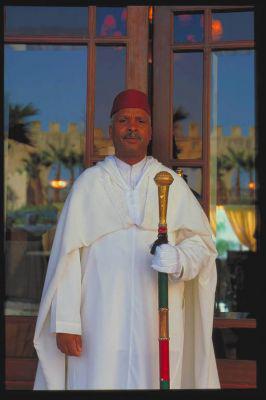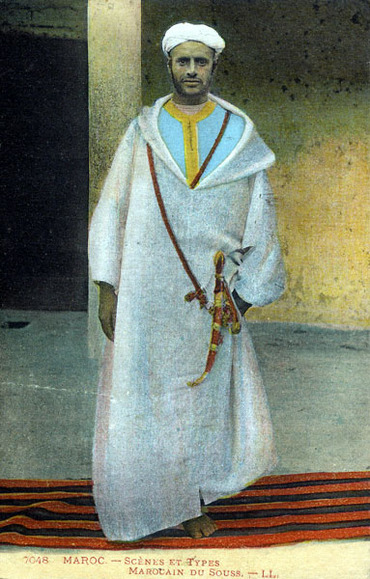Men usually only wear a djellaba on special occasions, sometimes topped with the famous Moroccan red cap, called a fez or tarbouche, and yellow leather slippers, known as baboush or belgha. The woman’s djellaba is more colorful compared to the man’s, and nowadays djellabas are becoming shorter and slimmer. There are verses of the Koran that mention the djellaba as a garment to be worn by Muslim women. A djellaba is mostly worn outside the house and there are djellabas for every day as well as for special occasions.
Shot in the vast expanse of the world's largest desert, these stunning portraits of the Herero tribe of Namibia look like they're from a bygone age.
But, dressed in the costumes that have been appropriated from their colonial past, the men, women and children are taking part in a modern re-enactment of their peoples' bloody history.
The tribe's now traditional costumes, pictured here by Jim Naughten, are seen by anthropologists as a fascinating subversion of their former rulers' fashion, showing how the tribe survived a concerted effort by German colonialists to wipe them from the face of the earth.
 The history of Herero clothing is extraordinary. Rhenish missionaries first introduced Victorian dress, which the tribe gradually accessorised by adding, for example, cow horn headdresses.
The history of Herero clothing is extraordinary. Rhenish missionaries first introduced Victorian dress, which the tribe gradually accessorised by adding, for example, cow horn headdresses.
Later, during the 1904 war with Namibia's German colonisers, Herero tribe members claimed the military uniform of dead German soldiers.
Germany officially claimed their stake in a South African colony in 1884, calling it German South-West Africa until it was taken over in 1915.
 The first German colonists then arrived in 1892, and conflict with the indigenous Herero and Nama people began.
The first German colonists then arrived in 1892, and conflict with the indigenous Herero and Nama people began.
Between 1893 and 1903, the Herero and Nama peoples' land as well as their cattle were seized by militarily superior German forces who regarded them as subhuman.
Then in 1903, the Herero people learned that they were to be placed in reservations, leaving more room for colonists to own land and prosper.
German rule ended in 1915 when the German army was beaten by the South African - but, once liberated, the Herero men began not only dressing as much like their German oppressors.
 Herero women also affected the styles and the airs and graces of the Christian missionary ladies who had come among them in the 1890s.
Herero women also affected the styles and the airs and graces of the Christian missionary ladies who had come among them in the 1890s.
At the 100th anniversary of the massacre, German Minister for Economic Development and Cooperation Heidemarie Wieczorek-Zeul apologised for the crimes on behalf of all Germans.
But the clothes the Herero choose to wear, both men and women, are a permanent reminder of the great scar gashed in the tribe's history when they came close to being exterminated.
'This is in part assimilation to European culture, and also in part appropriation, a coming-to-terms with, and overcoming of history and the colonial experience,' he said.
Speaking about the clothes Herero women wear, he said: 'A correctly worn long dress induces in the wearer a slow and majestic gait.'
Today, there are around 250,000 Herero peoples in south-west Africa and the tribe is thriving.
But, dressed in the costumes that have been appropriated from their colonial past, the men, women and children are taking part in a modern re-enactment of their peoples' bloody history.
The tribe's now traditional costumes, pictured here by Jim Naughten, are seen by anthropologists as a fascinating subversion of their former rulers' fashion, showing how the tribe survived a concerted effort by German colonialists to wipe them from the face of the earth.
 The history of Herero clothing is extraordinary. Rhenish missionaries first introduced Victorian dress, which the tribe gradually accessorised by adding, for example, cow horn headdresses.
The history of Herero clothing is extraordinary. Rhenish missionaries first introduced Victorian dress, which the tribe gradually accessorised by adding, for example, cow horn headdresses.Later, during the 1904 war with Namibia's German colonisers, Herero tribe members claimed the military uniform of dead German soldiers.
Germany officially claimed their stake in a South African colony in 1884, calling it German South-West Africa until it was taken over in 1915.
 The first German colonists then arrived in 1892, and conflict with the indigenous Herero and Nama people began.
The first German colonists then arrived in 1892, and conflict with the indigenous Herero and Nama people began.Between 1893 and 1903, the Herero and Nama peoples' land as well as their cattle were seized by militarily superior German forces who regarded them as subhuman.
Then in 1903, the Herero people learned that they were to be placed in reservations, leaving more room for colonists to own land and prosper.
German rule ended in 1915 when the German army was beaten by the South African - but, once liberated, the Herero men began not only dressing as much like their German oppressors.
 Herero women also affected the styles and the airs and graces of the Christian missionary ladies who had come among them in the 1890s.
Herero women also affected the styles and the airs and graces of the Christian missionary ladies who had come among them in the 1890s.At the 100th anniversary of the massacre, German Minister for Economic Development and Cooperation Heidemarie Wieczorek-Zeul apologised for the crimes on behalf of all Germans.
But the clothes the Herero choose to wear, both men and women, are a permanent reminder of the great scar gashed in the tribe's history when they came close to being exterminated.
'This is in part assimilation to European culture, and also in part appropriation, a coming-to-terms with, and overcoming of history and the colonial experience,' he said.
Speaking about the clothes Herero women wear, he said: 'A correctly worn long dress induces in the wearer a slow and majestic gait.'
Today, there are around 250,000 Herero peoples in south-west Africa and the tribe is thriving.

































